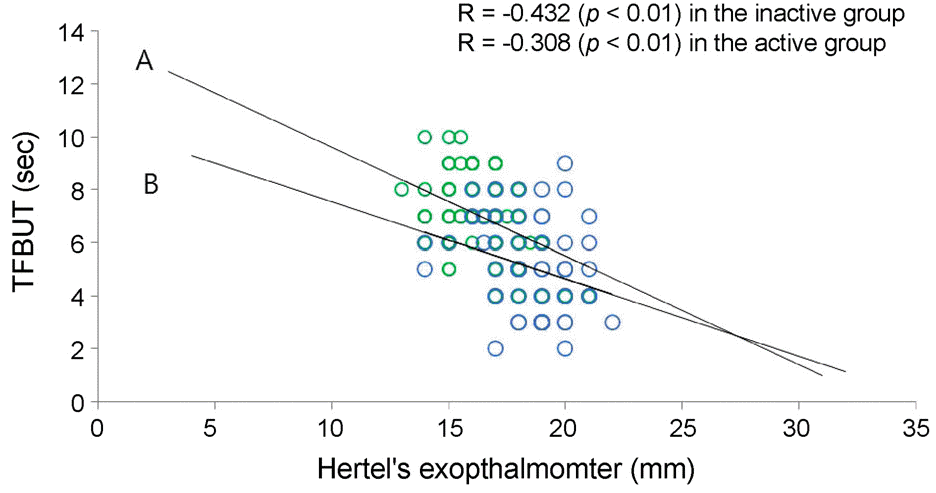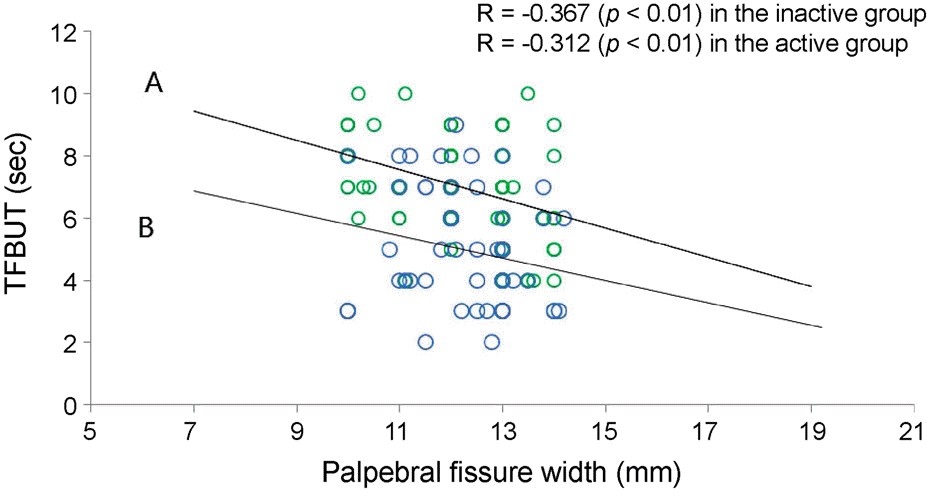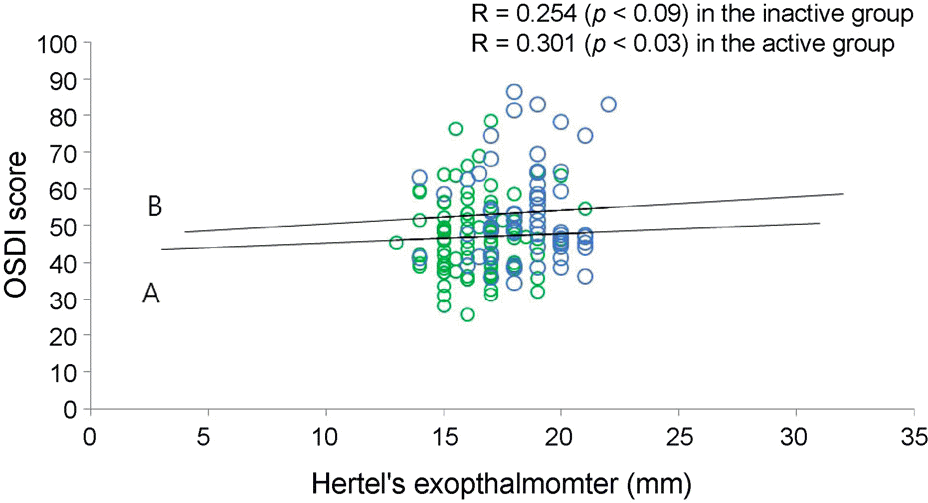Abstract
Purpose
To evaluate the clinical features of dry eye in thyroid-associated ophthalmopathy (TAO) according to disease activity and analyze the related factors.
Methods
This study included 157 patients diagnosed with TAO and dry eye between March 2009 and March 2015. According to the clinical activity score (CAS), TAO patients were divided into inactive (CAS < 3) and active (CAS ≥ 3) groups. Clinical features included age, sex, visual acuity, proptosis, palpebral fissure width, orbital computed tomography (CT) findings, thyroid hormones, and ocular surface parameters including tear film break-up time (TFBUT), Schirmer tests, keratoepitheliopathy scores, and ocular surface disease index (OSDI) were obtained and compared between the groups. In addition, correlations between clinical features and ocular surface parameters were analyzed in both groups.
Results
In the inactive and active TAO groups, CAS was 1.24 ± 0.69 and 4.23 ± 1.13, respectively (p = 0.001). Thyrotropin-binding inhibitory immunoglobulin was significantly higher in the active TAO group than in the inactive TAO group (p = 0.048). On orbital CT, extraocular muscle hypertrophy was more common in the active TAO group than the inactive TAO group (p = 0.020). No significant difference was found in age, sex, visual acuity, free T4, and thyroid-stimulating hormone between the two groups. During analysis of the tear film and ocular surface parameters, TFBUT (p = 0.006) was shorter and OSDI score (p = 0.028) was higher in the active TAO group than the inactive TAO group. TFBUT was negatively correlated with proptosis (r = −0.432, p = 0.001; r = −0.308, p = 0.032) and palpebral fissure width (r = −0.367 p = 0.012; r = −0.312, p = 0.031) in both groups. OSDI was positively correlated with proptosis in the active TAO group (r = 0.301, p = 0.033).
References
1. Bothun ED, Scheurer RA, Harrison AR, Lee MS. Update on abdominal eye disease and management. Clin Ophthalmol. 2009; 3:543–51.
3. Smith TJ, Hoa N. Immunoglobulins from patients with Graves' disease induce hyaluronan synthesis in their orbital fibroblasts through the self-antigen, insulin-like growth factor-I receptor. J Clin Endocrinol Metab. 2004; 89:5076–80.

4. Mizen TR. Thyroid eye disease. Semin Ophthalmol. 2003; 18:243–7.
5. Bartalena L, Pinchera A, Marcocci C. Management of Graves' abdominal: reality and perspectives. Endocr Rev. 2000; 21:168–99.
6. El-Kaissi S, Frauman AG, Wall JR. Thyroid-associated abdominal: a practical guide to classification, natural history and management. Intern Med J. 2004; 34:482–91.
7. Brasil MV, Brasil OF, Vieira RP, et al. Tear film analysis and its abdominal with palpebral fissure height and exophthalmos in Graves' ophthalmopathy. Arq Bras Oftalmol. 2005; 68:615–8.
8. Rocha EM, Mantelli F, Nominato LF, Bonini S. Hormones and dry eye syndrome: an update on what we do and don't know. Curr Opin Ophthalmol. 2013; 24:348–55.
9. Kim JR, Yim HB, Chung SK. Risk factors for dry eye in abdominal-associated ophthalmopathy. J Korean Ophthalmol Soc. 2011; 52:771–6.
10. Gilbard JP, Farris RL. Ocular surface drying and tear film abdominal in thyroid eye disease. Acta Ophthalmol (Copenh). 1983; 61:108–16.
11. Bartley GB, Gorman CA. Diagnostic criteria for Graves' ophthalmopathy. Am J Ophthalmol. 1995; 119:792–5.

12. Nerad JA. The diagnostic approach to the patient with proptosis. Krachmer JH, editor. Oculoplastic Surgery. 3rd ed.St Louis: Mosby;2001. 1:chap. 13.
13. Park JM, Ahn HB, Lee JH. The clinical features and the change of extraocular muscle at the first visit in hyperthyroidism patients. J Korean Ophthalmol Soc. 2003; 44:2197–203.
14. Jeon SJ, Baek JW, Doh SH, Chung SK. Tear meniscus evaluation using optical coherence tomography in meibomein gland dysfunction patients. J Korean Ophthalmol Soc. 2015; 56:1684–91.

15. Sahai A, Malik P. Dry eye: prevalence and attributable risk factors in a hospital-based population. Indian J Ophthalmol. 2005; 53:87–91.

16. Calonge M, Diebold Y, Sáez V, et al. Impression cytology of the abdominal surface: a review. Exp Eye Res. 2004; 78:457–72.
17. Mourits MP, Prummel MF, Wiersinga WM, Koornneef L. Clinical activity score as a guide in the management of patients with Graves' ophthalmopathy. Clin Endocrinol (Oxf). 1997; 47:9–14.

18. Jung HH, Kang YS, Sung MS, Yoon KC. Clinical efficacy of abdominal 3% diquafosol tetrasodium in short tear film break-up time dry eye. J Korean Ophthalmol Soc. 2015; 56:339–44.
19. Chang IB, Park JH, Kim MS, Kim TJ. Effect of sodium abdominal and cyclosporine A on tear film in dry eye syndrome. J Korean Ophthalmol Soc. 2013; 54:231–6.
20. Choi W, Lee SH, Yoon KC. Analysis of CCL5 concentration in tears of dry eye patients. J Korean Ophthalmol Soc. 2011; 52:658–64.

21. Lee JS, Choi W, Lee SS, Yoon KC. Prevalence and clinical aspects of Sjögren syndrome in dry eye patients. J Korean Ophthalmol Soc. 2012; 53:499–504.

22. Lee YH, Lee JE, Lee HJ, Lee SB. Usefulness of exophthalmos measurement on upgaze. J Korean Ophthalmol Soc. 2012; 53:924–8.

23. Seo HR, Ahn HB. Morphological changes of the eyelid according to age. J Korean Ophthalmol Soc. 2009; 50:1461–7.

24. Gürdal C, Saraç O, Genç I, et al. Ocular surface and dry eye in Graves' disease. Curr Eye Res. 2011; 36:8–13.

25. Yeatts RP. Quality of life in patients with Graves ophthalmopathy. Trans Am Ophthalmol Soc. 2005; 103:368–411.

26. Villani E, Viola F, Sala R, et al. Corneal involvement in Graves' abdominalopathy: an in vivo confocal study. Invest Ophthalmol Vis Sci. 2010; 51:4574–8.
27. Türkyı lmaz K, Öner V, Ş ahin SB, et al. Tear film osmolarity in abdominals with Graves ophthalmopathy. Eur J Gen Med. 2014; 11:15–9.
28. Eckstein AK, Finkenrath A, Heiligenhaus A, et al. Dry eye abdominal in thyroid-associated ophthalmopathy: lacrimal expression of TSH receptor suggests involvement of TSHR-specific abdominal. Acta Ophthalmol Scand. 2004; 82(3 Pt 1):291–7.
29. Hwang DJ, Kim YJ. Association between thyroid associated oph-thalmopath and thyroid autoantibody. J Korean Ophthalmol Soc. 2010; 51:1167–73.

30. Woo YJ, Jang SY, Lim THT, Yoon JS. Clinical association of abdominal stimulating hormone receptor antibody levels with disease abdominal in the chronic inactive stage of Graves' orbitopathy. Korean J Ophthalmol. 2015; 29:213–9.
31. Ponto KA, Kanitz M, Olivo PD, et al. Clinical relevance of abdominal-stimulating immunoglobulins in graves' ophthalmopathy. Ophthalmology. 2011; 118:2279–85.
32. Jang SY, Shin DY, Lee EJ, et al. Correlation between TSH receptor antibody assays and clinical manifestations of Graves' orbitopathy. Yonsei Med J. 2013; 54:1033–9.

33. Huang D, Luo Q, Yang H, Mao Y. Changes of lacrimal gland and tear inflammatory cytokines in thyroid-associated ophthalmopathy. Invest Ophthalmol Vis Sci. 2014; 55:4935–43.

34. Xu N, Huang D, Yang H, et al. Ocular surface characteristics and impression cytology in patients with active versus inactive Thyroid Eye Disease. Eye Sci. 2012; 27:64–8.
35. Labbé A, Liang Q, Wang Z, et al. Corneal nerve structure and function in patients with non-Sjogren dry eye: clinical correlations. Invest Ophthalmol Vis Sci. 2013; 54:5144–50.
Figure 1.
Correlations between proptosis and tear film break-up time (TFBUT) in the inactive (A) and active (B) thyroid-associated ophthalmopathy groups.

Figure 2.
Correlations between palpebral fissure width and tear film break-up time (TFBUT) in the inactive (A) and active (B) thyroid-associated ophthalmopathy groups.

Figure 3.
Correlations between proptosis and ocular surface disease index (OSDI) score in the inactive (A) and active (B) thy-roid-associated ophthalmopathy groups.

Table 1.
Clinical features of thyroid-associated ophthalmopathy patients with dry eye according to disease activity
| CAS < 3 (n = 90) | CAS ≥ 3 (n = 67) | p-value | |
|---|---|---|---|
| Mean age (years)* | 41.58 ± 15.50 | 44.18 ± 10.84 | 0.224 |
| Sex (male/female)† (n, %) | 19/71 (21.1/78.9) | 21/46 (31.3/68.7) | 0.172 |
| Visual acuity (log MAR)* | 0.05 ± 0.19 | 0.11 ± 0.39 | 0.378 |
| Clinical activity score* | 1.24 ± 0.69 | 4.23 ± 1.13 | 0.001 |
| Proptosis (mm)* | 16.37 ± 1.54 | 17.01 ± 1.72 | 0.060 |
| Palpebral fissure width (mm)* | 12.21 ± 1.17 | 12.34 ± 1.02 | 0.125 |
| EOM enlargement in orbital CT† (n, %) | 35 (38.9) | 39 (58.2) | 0.020 |
| Thyroid hormone state | |||
| Hyperthyroid state† (n, %) | 47 (52.2) | 40 (59.7) | 0.069 |
| Euthryoid state† (n, %) | 39 (43.3) | 15 (22.4) | 0.090 |
| Hypothyroid state† (n, %) | 4 (4.4) | 2 (3.0) | 0.053 |
| Thyroid hormone | |||
| TSH (μ IU/mL)* | 3.73 ± 11.99 | 2.35 ± 0.47 | 0.761 |
| fT4 (ng/dL)* | 1.67 ± 1.04 | 1.38 ± 0.53 | 0.388 |
| TBII (IU/L)* | 6.22 ± 7.54 | 8.05 ± 4.15 | 0.048 |
Table 2.
Comparisons of the tear film and ocular surface parameters between inactive and active thyroid-associated ophthalmopathy patients
| CAS < 3 (n = 90) | CAS ≥ 3 (n = 67) | p-value | |
|---|---|---|---|
| Tear film break-up time (sec)* | 7.20 ± 1.25 | 5.37 ± 1.84 | 0.006 |
| Schirmer test (mm)* | 8.75 ± 2.19 | 8.28 ± 1.39 | 0.053 |
| Keratoepitheliopathy score* | 1.59 ± 0.14 | 2.54 ± 0.86 | 0.061 |
| OSDI score* | 47.11 ± 10.13 | 53.35 ± 12.84 | 0.028 |
Table 3.
Correlation analysis in inactive thyroid-associated ophthalmopathy patients
Table 4.
Correlation analysis in active thyroid-associated ophthalmopathy patients




 PDF
PDF ePub
ePub Citation
Citation Print
Print


 XML Download
XML Download